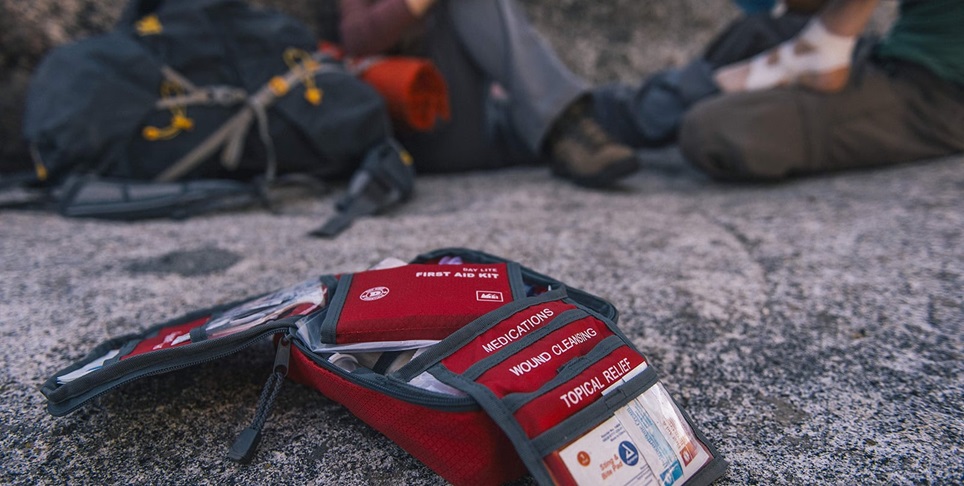How to Choose First Aid Kits

A first-aid kit, as well as the training to use it, is one of the Ten Essentials that’s universally known yet rarely thought about. When you need to reach for yours, though, you’ll be grateful for the time you spent to ensure yours is up to the task.
Even if you pack only a small first-aid kit, you’ll have a great resource for treating minor issues and for preventing them from becoming major ones. Managing aches and pains also makes any trip more enjoyable.
You can buy a premade kit or make your own. This article offers tips on both approaches to getting yourself a first-aid kit for the outdoors.
Remember to check the contents of your kit before every season. Regardless of its size, medications can expire, and bandages and ointments may need replenishing.
Premade First-Aid Kits
Many people opt for premade first-aid kits to save time and money compared to buying individual supplies and assembling their own kit. Another advantage of premade kits is that they help ensure you don’t overlook any important supplies or tools.
When choosing a kit, consider the following:
Group size: Kit-makers usually estimate the number of people a kit will serve. Your actual needs may vary. Kits for larger groups typically include more consumables, like bandages and pain medication. Medical tools, such as thermometers, tweezers, and splints, remain fairly consistent from kit to kit.
Trip length/distance: You’ll usually find an estimated number of days a kit is designed for in its product description.
Trip activity: Some kits are tailored to specific activities. For example, a kit with a fully waterproof pouch is ideal for paddling, while smaller, lighter kits are suited for light-and-fast pursuits like trail running. Larger, more comprehensive kits are perfect for activities like car camping.
Comprehensive kits: Even if you don’t know how to use everything, having a kit with advanced tools and supplies can be valuable because others in your group or area might have greater medical knowledge. You can also grow into your kit by getting medical training.
Next, consider the following additions, regardless of the kit you choose:
Trip risks: If you’re heading to an area with poison ivy and ticks, consider adding a poison ivy treatment and a tick-specific tool to your kit.
Special needs: If you require prescription medications or an EpiPen in town, add them to your outdoor first-aid kit. On group trips, survey members so that everyone is aware of special supplies in each person’s kit.
How many kits should you get? Consider the following:
Always pack an individual kit: Even if someone else has a large kit for your group, you still need to be able to treat personal nicks and scratches. The person carrying the group kit might not always be close at hand.
Consider multiple kits: Just as you use different packs for day hiking, backpacking, and cycling, it makes sense to have different first-aid kits for various activities.
Build Your Own First-Aid Kit
You’ll need a water-resistant bag or pouch to hold everything. Additionally, an assortment of zip-lock plastic bags, plastic pill bottles, a waterproof marker, and tape for labeling will be helpful. After that, it’s simply a matter of purchasing or gathering the supplies to fill your kit.
We highlight some basic essentials below. For a more comprehensive supply list, see our first-aid checklist.
First-Aid Kit Basics
Bandages:
- Assorted adhesive bandages
- Gauze
- Athletic tape
- Blister treatments (such as moleskin)
Medication and ointments/lotions:
- Ibuprofen
- Antibiotic ointments
- Antacid tablets
- Antidiarrheal pills
- Rehydration salts
- Prescription medicines
Basic tools:
- Tweezers
- Small mirror
- Blunt tip scissors
- Razor blade or knife
Miscellaneous items:
- Bee-sting kit
- Tick remover
- Antiseptic towelettes
- Burn dressing
- Splints and elastic wraps
First-Aid Kit Instructions
Always include a quick-reference guide or a more comprehensive booklet that explains how to administer first aid. Kit-makers pay close attention to the quality of their guides, so you should do the same.
Trip-Specific First-Aid Supplies
Just as you would with a premade kit, you should supplement your home-assembled kit with extra supplies for a longer trip or special supplies for your destination, activity, and group members.
Additional Outdoor Safety Essentials
Some essentials are closely related to first aid: a heat-reflecting blanket (to prevent hypothermia or help treat shock), sunscreen, bug repellent, and hand sanitizer should all be carried in or near your kit.
If you ever face a truly life-threatening medical emergency in the backcountry, a personal locator beacon or satellite messenger can be a lifesaver. While signal strengths and operational details differ, each device can convey your need for rescue and your location to emergency responders.
First-Aid Training
Even though quality kits come with reference materials, getting first-aid training before your trip is a wise move.
A first-aid guide does not convey the true nature of a medical trauma. Training will help you overcome the initial fear and shock of responding to an emergency. Being fully prepared to deal with a serious incident beforehand can make all the difference.
